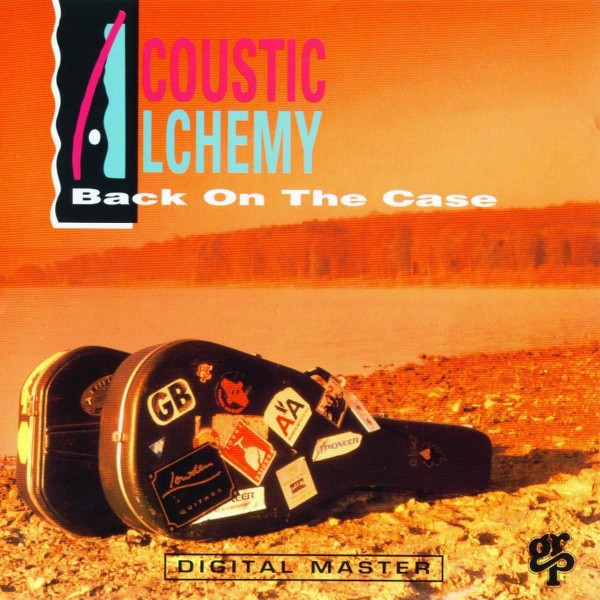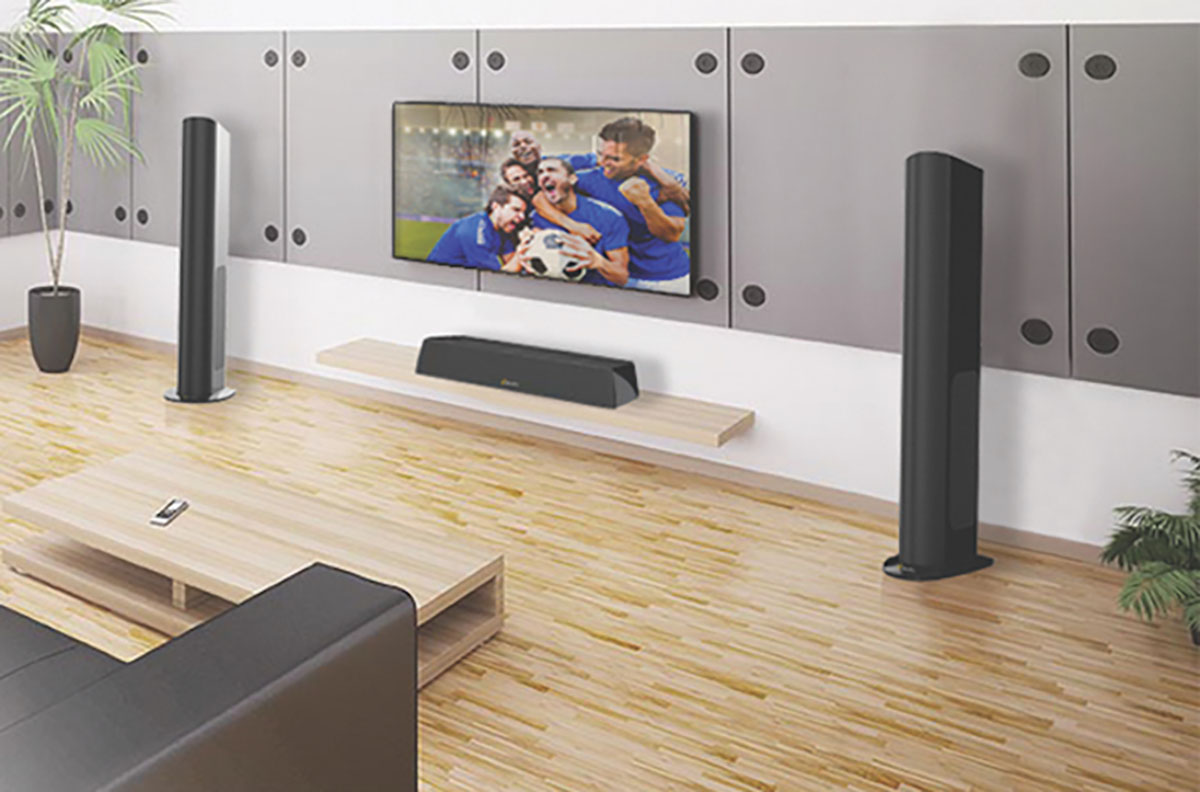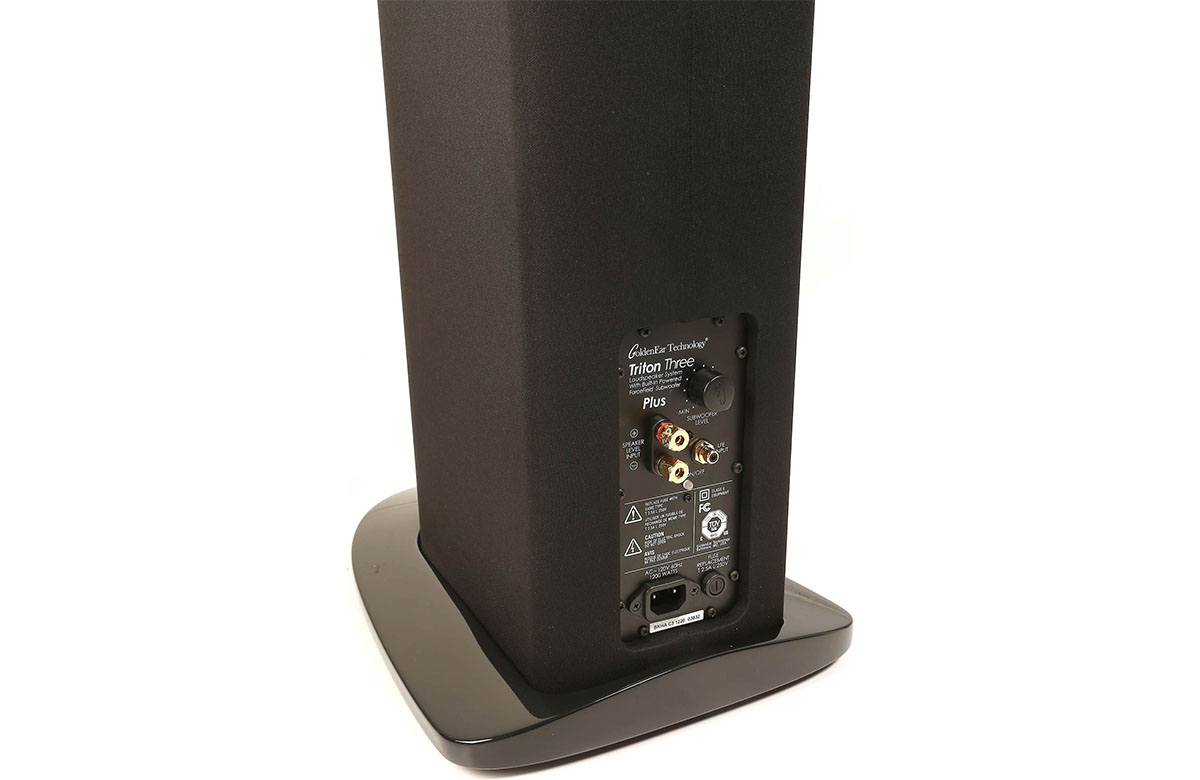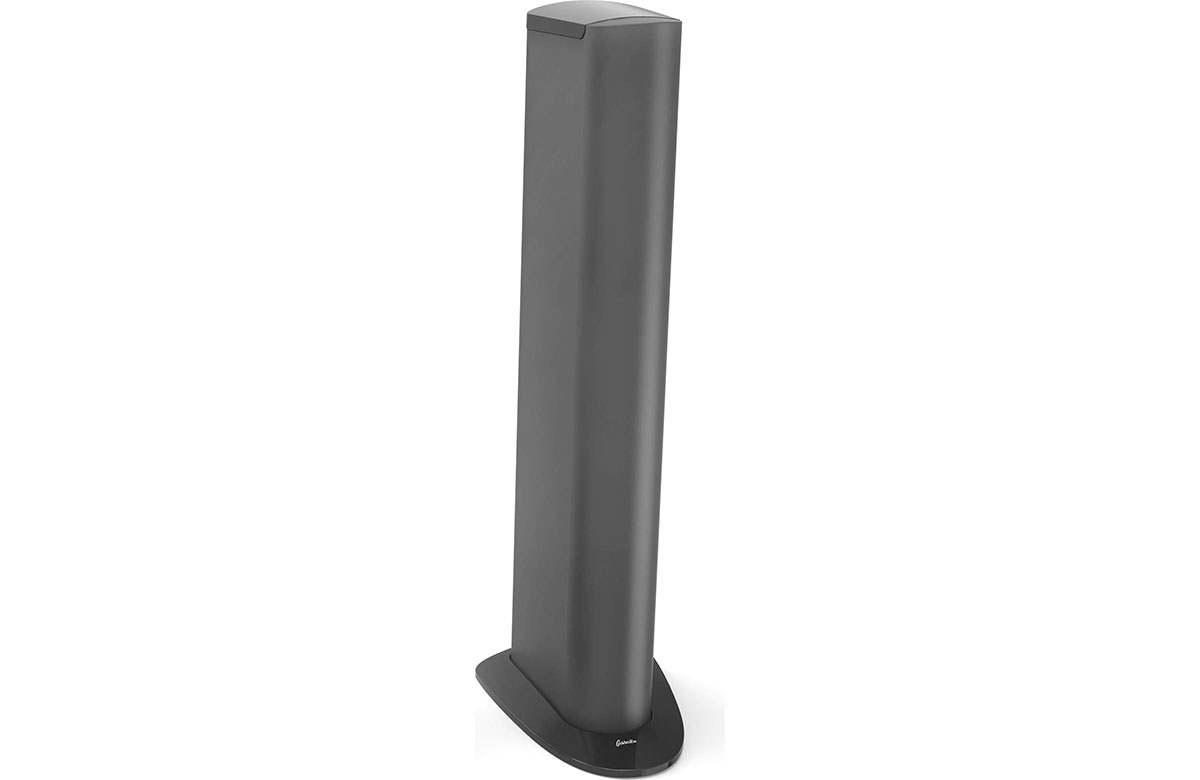But even being a discontinued model, a close examination of the strengths and weaknesses of these speakers is a necessary foundation for future comparison. Designed by Sandy Gross, the Three+ models have some startling virtues. These will be best appreciated at reasonable volumes in normal-sized rooms. If you’re powering a football stadium, a frat house, or an auditorium, seek the larger GoldenEar products that have more cone area.
The GoldenEar Triton Three+ Loudspeakers Highlights
- The GoldenEar Triton Three+ floor-standing speakers feature a built-in, powered woofer that reduces current demand on the upstream amplifier.
- Compatible with 8-Ohm impedance (nominal 4-Ohms) and works with almost any amplifier.
- No subwoofer is needed for most rooms.
- Black cosmetics only.
- Can be picky about room placement and amplification.
The GoldenEar Triton Three+ loudspeakers are an exceptional value that responds strongly to careful placement in the listening room. With their powered woofers, they would succeed in most rooms without an external sub. These are NOT comparable to wimpy bookshelf speakers. These speakers have bass!
The GoldenEar Triton Three+ speakers are specified as “compatible with 8 Ohms.” Their actual impedance drops slightly below 4 Ohms between 225 and 650 Hz. This is a broad range of frequencies, and right in the middle of the musical range, but (and this is a very important “but”), the speakers should be safe to use with even the most modest Audio-Video Receiver (AVR) provided one doesn’t want “volume at 11.” Most of the electrical current demand (as opposed to voltage demand) on an amplifier output stage is in the bass frequencies. The Three+ speakers have woofers driven by an internal amplifier, and the bass impedance, as seen by the driving amplifier, will be so high that even the wimpy amps in AVRs should be happy.
The GoldenEar Triton Three+ speakers have a specified frequency response from 21Hz to 35kHz. Your own in-room response will vary, of course, but for the average listener, at average volumes, and in average rooms, these speakers will probably not require an external subwoofer. If, however, you have a large listening room and/or if you want dinosaur stomps that you can feel in your diaphragm, GoldenEar’s ForceField subwoofers are available to supplement these speakers.
The Plus version of these speakers differs from the original Triton Threes in several ways:
- The upper bass/midrange driver uses a new polypropylene cone, an improved surround, a more robust voice coil, and a modified spider
- A new crossover is used that includes polypropylene capacitors
- The low-frequency Digital Signal Processing (DSP) unit has been reprogrammed to better control the bass
GoldenEar recommends amplifiers from 20 to 400 watts per channel. This includes almost every amp on the market unless you’re using a single-ended triode tube unit. However, with a sensitivity of 90dB at one watt / one meter, even single-ended triode tube amplifiers should be able to drive these speakers to normal listening levels. During the review, I hooked up my 12-watt Heathkit monoblock amps, and they provided more than sufficient volume for my needs, even in my relatively large listening room.
GoldenEar states that the speakers with their integral base should be stable on both hard and carpeted floors with no need for outriggers. Both threaded rubber feet and threaded spikes are supplied. When I asked about the advisability of adding outriggers, GoldenEar replied that they had not thought outriggers necessary or advantageous with the existing speaker bases.
With just a single midrange driver, getting a good blend between the mid and the tweeter will be enhanced by having the listener’s ears close to or slightly above the vertical axis of the tweeter. To facilitate this, the included rubber feet and spikes can be screwed in and out of the base as needed to put the tweeter axis at the plane of the listener’s ears. In the rare cases where the vertical alignment adjustments from the threaded feet can’t put the tweeter on axis, GoldenEar recommends that the listener’s ear be slightly above the tweeter axis (this may or may not be true for GoldenEar’s speakers that use two midrange drivers in a mid-tweet-mid (d’Appolito) configuration). With the Three+ speakers, I tried on-axis, ears slightly below the tweeter, and ears slightly above the tweeter. I found that having my ears on-axis or above the tweeter provided the smoothest frequency response although every elevation sounded at least pretty good.
I asked GoldenEar about their attitude concerning the use of cable risers for speaker cables. They replied “Cable risers reduce the amount of RF noise that capacitively couples into the speaker cables through all flooring materials. Successfully designed and properly used, cable risers will preserve valuable low-level detail for more natural, dynamic, and involving performance.” Based on their recommendation, I purchased some plastic risers and tried them. Results – In my room, and to my ears – no difference. HOWEVER… I have hard floors. One of my audio amigos has a deep carpet and a thick pad below it. He claims that in his room, the use of the cable risers does make an audible difference. Since you can buy polypropylene rebar cradles from Lowes for 0.68 each, why not try them?
As Henry Ford famously said of his Model T – You can have any color you want so long as it’s black. The GoldenEar Triton Three+ speakers come with a gloss black cap over a black fabric wrap that covers the entire cabinet. If like me, you’d prefer wood grain speakers, you’re out of luck. However, the narrow visual aspect of the speakers from the front minimizes the “black effect.” I’d still have preferred a wood grain finish on the bases and caps, but it is what it is.
Dimensions:
5.3” Wide (13.3 cm) Front
7” Wide (17.8 cm) Rear
12.9” Deep (33 cm)
44” Tall (111.8 cm) With base installed – no spikes
11.5” Wide (29.2 cm) Base
16.2” Deep (41.3 cm) Base
Weight:
45 Pounds (20.4kg) per speaker
53 Pounds (24kg) shipping weight
Frequency Response:
21Hz – 35kHz
Efficiency:
90dB
Nominal Impedance:
4Ω (Compatible with 8Ω)
Driver Complement:
One – 5˝ x 9˝ Long-Throw Quadratic Subwoofer Bass Driver, coupled to
Two – 6.8˝ x 8˝ Quadratic Planar Infrasonic Radiators
One – 4.5˝ High-Definition Cast-Basket MVPP™ Upper-Bass/Mid Driver
One – HVFR™ High-Velocity Folded Ribbon Tweeter
Recommended Amplification:
20 – 400 watt/channel
Built-In Subwoofer Amplification:
800-watt ForceField™ Amplifier
Break-In:
40-60 Hours recommended
Inputs:
1-Pair 5-way Speaker binding posts
1 RCA jack for HT LFE material (optional)
Controls:
Subwoofer level dial
Pilot light
IEC AC cord jack
Internal overload protection for the subwoofer amplifier
Manufacturer’s Suggested Retail Price:
$1,800 each
$3,600 per pair
Warranty:
5 years – Drivers & cabinets
3 years – Electronic components
Website:
Company:
SECRETS Tags:
GoldenEar, Triton Three+, Floor Standing Speaker Review, 2022
- GoldenEar original Triton Three review by Piero Gabucci
- GoldenEar Triton Two+ review by Yongki Go
- GoldenEar Triton One. R review by Piero Gabucci
To unpack the GoldenEar Triton Three+ speakers, you need to pick them out of their shipping crates laid flat on the floor. You can’t stand the speakers up and lift the boxes off them as with most speakers. Once out of the crates, you need to lay the speakers on a table (on a towel, please) and hang the bottom over the table edge. Then you attach the bases by pushing the attachment screws through the speakers’ fabric sleeve. It seems crude but worked fine. If you want to attach the spikes to the base, then this is the time to unthread the rubber feet and screw the spikes into the base. If like me, you have hard floors (and want a slight bit more speaker height), then you can purchase threaded Teflon sliders from your local hardware store and use them in lieu of the spikes or rubber feet. This allows for better leveling of the speakers on uneven floors without having to scratch your hard floors with the spikes. The factory-supplied rubber feet are threaded but the short, threaded stems don’t allow for much vertical adjustment. The spikes have longer threads.
Secrets Sponsor
The GoldenEar Triton Three+ speakers created the widest image in my room when arranged in an equilateral triangle with the listening position about 10 feet apart and with the fronts of the speakers about three feet from the wall behind them. They worked best toed in almost on-axis with the listening position and with the tweeters slightly below the axis in relation to the listener’s ears.
But the position that gave the best image width was not the position that yielded the best image depth. Moving the speakers closer together increased image depth but decreased image width. So, there’s a trade-off in speaker positioning between width and depth. This isn’t unique to the GoldenEar Triton Three+ speakers, but the revealing nature of these towers makes the imaging more noticeable.
Note, also that with the Triton Three+ speakers, you aren’t just trying to position the speakers for a good compromise between image width and depth. There is a third variable that room placement has a huge impact on, and that is bass response. Having a self-powered woofer can be both a blessing and a curse. With bookshelves or towers that have no significant bass, you can place the speakers for best imaging only and then cross over to a subwoofer that can be optimally located for bass. But the Triton Three+ speakers DO have deep bass all on their own.
Place the speakers too close to the wall behind them, and you’ll get apocalyptical bass with shudders throughout your entire neighborhood. Although this might be quite the ticket for dinosaur stomps and organ pedal tones, it can make an acoustic bass sound like mud.
If you move the speakers even the slightest bit too far out into the room, the speakers will sound like stand-mounted bookshelf units. The optimistic owners’ manual instructs you to adjust bass by using the bass gain dial on the speakers’ plate amps, but this does NOT always adequately compensate for room effects. I left my Triton Three+ speakers with their bass dials at 12 o’clock until I found the best location for imaging AND bass tightness. Then and only then did I start adjusting the bass gain dial.
I’d also say that despite the built-in digital signal processing that is intended to maintain balance at the crossover frequency between the active woofer and the passive midrange regardless of the bass gain settings, some midrange effects can still be heard with changes to the bass gain dial.
Don’t take the above paragraphs as a criticism of the speakers. They’ll sound good (even very good) wherever you might need to put them. But you’ll get the very best performance by experimenting with placement. I think I have my Triton speakers optimized for the best of both imaging and bass performance, but I still plan to invite my audio amigo whom I’ve nicknamed “the speaker dancer” over to see if he can do better.
Secrets Sponsor
Since my floors are hard instead of carpeted, I began with rubber feet rather than spikes. Having the top of the speakers beveled from front to back prevented me from using either my bubble level or my laser pointer for vertical adjustment. I’ll assume that GoldenEar opted to angle the top to minimize internal cabinet reflections, but it makes vertical adjustment harder for the user. On my uneven floor, I eventually removed the rubber feet and went with threaded Teflon sliders. With the sliders, I was able to prevent the speakers from rocking and slightly tilt them down (back to front) so that the tweeters fired below my ear level.
A word also needs to be said about the GoldenEar Triton Three+ speakers and amplification. These speakers are transparent enough that you WILL hear the differences in amplifiers that you might choose to use with them. Use an amplifier with the least bit of emphasis on the presence range of frequencies, and you’ll need to use toe-in/toe-out to prevent the speakers from sounding too bright. This characteristic makes most vacuum tube amplifiers (with their warm sound) and most pro amplifiers (with their glassy midrange) inappropriate for these speakers. I tried the Living Sound Audio VT-150 tube power amplifier, the Black Ice Audio F-22 tube integrated amplifier, the AB Precedent II 600LX pro amplifier, the Sonance Sonamp 260 Mk. II pro amplifier, and the Crown PSA-2 pro amplifier with the Triton Three+ speakers, and found every one of them a touch too bright in the midrange.
The best match I found for the Triton Three+ speakers were the Emotiva PA-1 pro monoblock power amplifiers (based on the Class-D Bang & Olufsen ICE modules). These, for whatever reason, provided both smoothness and dynamics.
That said, I didn’t find the speakers to sound bad with any of the amps I tried – but they definitely expressed their preference for some amplifiers over others.
Having reviewed GoldenEar’s excellent BRX Bookshelf Speakers, I was hopping about on tiptoes in anticipation of hearing the GoldenEar Triton Three+ tower speakers. The Triton Three+ models occupy one of the most popular consumer price points for upper entry-level home loudspeakers, between $3,000 and $4,000 per pair.
Associated equipment used in this review:
Front End:
- Mac mini running Roon software
- Intel NUC running Roon-Optimized-Çore-Kit software
- iPad with Roon-Remote control software
- External 6TB USB HDD with music library
- AudioQuest Carbon USB cable
Middleware:
- Apple TV-3 used as an Ethernet to USB audio streamer
- Emotiva Stealth DC-1 DAC with variable volume used as DAC/Preamp
- Topping D-10s DAC with passive remote-control volume box
- AudioQuest Pearl USB cable
- AudioQuest Carbon RCA interconnects
- AudioQuest Diamondback XLR interconnects
Amplification:
- Black Ice F22 stereo tube integrated amplifier (EL-34 outputs)
- Emotiva PA-1 solid-state, class-D mono power amplifiers
- AB Precedent Series 600LX pro stereo solid-state amplifier
- Crown PSA-2 pro stereo solid-state amplifier
- Sonance Sonamp 260 Mk. II stereo solid-state amplifier
- AudioQuest Rocket 44 speaker cables
- Belden speaker cables
- Carnare speaker cables
Speakers:
- Klipsch RP-600m bookshelf speakers with StarkeSound S-15 subwoofer
- GoldenEar Triton Three+ tower speakers with built-in, self-powered subwoofer
Listening room:
- Treated with absorbers & diffusers

Jack Clement “All I Want to Do in Life”
To the best of my knowledge, you won’t find this song on a CD. To get a digital copy, I had to purchase a copy of the vinyl album and let one of my audio amigos use his expensive turntable, cartridge, and pro Teac equipment to digitize the album to 16-bit, 44.1kHz files. Since I was fortunate enough to find a brand-new source album, my digital file is free from hiss, ticks, and pops. And it sounds amazing! There is a chorus of whispers throughout the album that is hair-raising when reproduced through the GoldenEar Triton Three+ speakers. The tweeters nail both the breathiness and the clarity of the singers without ever sounding excessively sibilant. Mr. Clement’s voice is in the room with you, and the song just sounds “right.” Over my Klipsch RP600m speakers, the male voice lacks the same body, and the whispers have too much “tizz” and not enough “breath.” The Tritons avoid these shortcomings.

Caro Emerald “Deleted Scenes from the Cutting Room Floor”
The CD source I’ve listed is the official version of this song, but I find (as I do in many cases) the live performance on YouTube to be by far the superior choice. Having downloaded the YouTube performance, stripped out the audio, and saved it as a .wav file, I now have the performance available and, to my ears, sounding better than the direct stream from YouTube. Yes, I bought Ms. Emerald’s CD and am happy to have done so, but I sure wish that performers would offer CD-quality releases of their live YouTube performances. So how does this song sound? The soundstage opens up and you feel that you’re among the outdoor crowd listening to the performance. No, the band isn’t quite as tight as in the studio version, but the soundstage ambiance more than compensates. The Triton speakers gave a performance wider than the plane of the speakers and maintained the excitement of the performance. You couldn’t ask for more.

Acoustic Alchemy “Back on the Case”
This is one of my audio amigo’s favorite test tracks. He says that the crispness of the percussion and the air around the instruments are his immediate litmus test of how good an audio system is. He claims that after the first few minutes of this track, he can diagnose any and all problems with an audio system. I’d agree that this is a good test track and that it shines on the GoldenEar Triton Three+ speakers. My wife, walking through the living room, stopped dead in her tracks to listen to this cut. It sounded that good.

Goran Bregović “Champagne for Gypsies”
This is an unusual cut that you’ll either love or you’ll hate. The voice is vivid, the guitar interlude is sweet and airy, and the recording is excellent. Several audio equipment manufacturers, having heard this cut, have opted to use it as a demonstration track for their gear at audio shows. When you hear it, you’ll know why.

Valor “What it Took”
This unusual track uses a frequency divider on the bass singer’s voice. The result is shudderingly deep bass that most speakers can’t even come close to reproducing. In fact, most subwoofers also have trouble reproducing this track. Even if the subs can produce the bass, most of them lose the sense of continuity and cohesion between the singer’s voice and the electronically synthesized underpinnings. The deep bass distortion that is not audible on most audio signals becomes clear and evident with this song. The Triton Three+ speakers do as good a job as most subwoofers on this track, and depending on speaker placement, they can do better than many subs.

Pentatonix “Christmas”
Lots of synthesized special effects on this music, but they are very well done. The stylings of Pentatonix are not to everyone’s tastes, but this particular track is definitely demonstration material. The Triton Three+ speakers lose only the slightest edge to the Klipsch RP600m speakers in terms of dynamics, but the Tritons are far, far smoother in their frequency response, and it shows here.

Singers Unlimited “Christmas”
Not only should the voices in this song sound real and in the room with you, but their placement in the soundstage should be clear and precise. This is an excellent vocal recording, and the Triton Three+ speakers do it justice.

Luther Kent “Jazzin’ on the Ritz”
This recording should take you to the New Orleans jazz club venue like a Star Trek transporter beam. When Luther and his band hit it, you are THERE! This is a great recording, and once again, the Tritons play it as well as any speakers I’ve heard in my room.
The GoldenEar Triton Three+ loudspeakers offer exceptional value thanks to their excellent sound, powered bass section, and compatibility with a wide variety of electronics.
- Amazingly deep, clean, powered bass
- Startling articulate and transparent midrange
- Crisp and extended ribbon tweeter without any harshness
- Compact and inert cabinet
- Alternate grille colors
- Alternate finish bases and caps instead of black
- Full frequency response curves and impedance curves in the owner’s manual
- Some convenient way to level the speakers
I’d have to point out that the GoldenEar Triton Three+ offers some of the best value of any speaker I’ve reviewed. Why?
First, unlike bookshelf speakers, the Three+ speakers don’t require stands. I have to say that in my experience, good stands aren’t cheap, and (generally) cheap stands aren’t good. So, if you consider “good stands” as being between $200 and $400 per pair, you can deduct that amount from the price of the Three+ speakers in comparison to any bookshelf model.
Second, unlike both bookshelf and most tower speakers, the Three+ speakers have real bass. Find me any tower speaker in the price range of the Three+ speakers that have the equivalent bass extension. I don’t think you can. This means that the Three+ speakers can, in most rooms and for most listeners, work fine without a subwoofer. This is not only a cost-saving, but it also omits the need for:
- A monophonic subwoofer output on the driving electronics
- The need to either use long wires or a wireless transmitter-receiver combination to get the subwoofer signal from the electronics to the (best) subwoofer location
- The intrusion of a large and generally ugly black subwoofer box in the listening area
Considering that good subwoofers can range from $1,000 up to $3,000 apiece, you can deduct that expense from the selling price of the Three+ speakers as well.
Third, any passive speaker will perform best in the bass only with a muscular, high-current amplifier. Such amplifiers are not inexpensive. The Three+ speakers, having their own bass amplifier, minimize current demands on the upstream amplifier. This is NOT a trivial issue. Most AVRs use the least expensive amplifiers they can get by with. If you’re using such a product, the Three+ speakers should deliver an order of magnitude better bass than any passive speaker could provide. There are possibly some exceptions to this statement, but in general, it is accurate.
Fourth, the GoldenEar Triton Three+ speakers are not merely average $3K/pair speakers. These Sandy Gross designs have been tweaked in an anechoic chamber and are designed to the guidelines of the Canadian National Research Council. These guidelines include wide horizontal dispersion and a smooth frequency response. The Three+ sounds better than the average speaker in their price range even if they didn’t have their built-in powered woofers. In fact, I’d estimate that equivalent sound quality wouldn’t be available in most other brands until you got into the five to six thousand per pair price range. Even then, you wouldn’t have the bass response of the Three+.
My ultimate conclusion is that you’d be lucky to get all the virtues of the GoldenEar Triton Three+ speakers for anything less than $6,000 to $8,000 per pair. And even then, you’d have to do some serious shopping…






